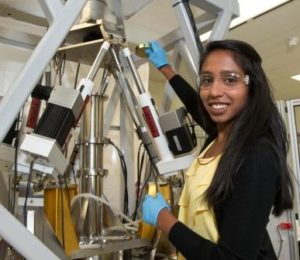
Back pain is a major health burden, with Australians spending an estimated $1 billion each year on treatments.
Researchers from Flinders University are now undertaking a study to identify the repetitive daily movements that lead to a herniation, or rupture, of the lumbar discs in the lower back with the help of visiting international fellow Dhara Amin from the University of Delaware in the US.
Working with Flinders biomechanics expert Dr John Costi in the University-based Medical Device Research Institute, Ms Amin will simulate various motion and load conditions such as forward, backward and side bending using an award winning Six Degree of Freedom Hexapod Robot.
The robot – developed by Dr Costi in collaboration with the University of Adelaide to enable realistic 3D loading of bones, joints and artificial implants – will help the researchers identify which combination of repetitive movements cause the greatest strain inside spinal discs and identify regions most susceptible to damage and herniation.
“Generally there’s not one single motion that causes a herniation because the human body is so complex – even when you’re walking you might be twisting so it’s a combination of movements that lead to a disc slip,” Ms Amin, who recently completed a degree in mechanical engineering, said.
“The spine basically holds your body up and when you move in certain ways you add load to it so the Hexapod will allow us to test different amounts of load and degrees of rotation that people use in everyday life to see what puts the most pressure on the spine,” she said.
“Sensors will be embedded into the discs prior to simulation to measure the extent of the tissue strains and provide a 3D model of the disc segments for further analysis.”
The findings, Ms Amin said, will improve understanding of the lumbar section of the spine and potentially result in new and improved strategies to prevent back pain and injury.
“If we can identify early indications of herniation based on how the disc reacts under different loads we might be able to come up with prevention plans to avoid the damage in the first place.”
Arriving in Adelaide in September, Ms Amin is conducting her year-long research under the Whitaker International Fellowship, a program which aims to help young biomedical engineers gain academic and laboratory experience outside of the US.
“The opportunity to be involved with leading research in orthopaedic biomechanics here at Flinders was ultimately what made me choose to come to Adelaide,” Ms Amin said.
“Being able to access equipment like the Hexapod Robot was also a massive influencer in my decision.”
After the fellowship, Ms Amin hopes to study the clinical applications of biomedical research, with her long-term goal to become a surgeon while running her own orthopaedic research lab.

